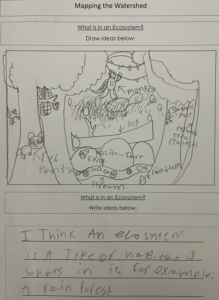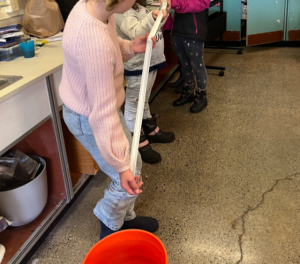Reflecting on October STEAM lessons for youth

Elementary school students walking along Longfellow Creek in West Seattle, recording day, time, temperature, and precipitation to learn about water moments.
This year, Delridge Neighborhoods Development Association’s (DNDA) fall STEAM lessons reached 120 students through September and October — nearly as many students as we typically serve in a whole year! October’s “Watershed Wonders” nature workshops were a hit with the kids.
“I didn’t realize water was all around us!” one student said.
Jules Hepp, DNDA’s environmental education coordinator, taught the STEAM lessons — science, technology, engineering, art, and math — to third through fifth graders from Louisa Boren STEM K-8 school in the Delridge neighborhood. DNDA’s STEAM lessons for youth launched in 2021 and are vital to engaging young kids with their local land.
The program started with students illustrating and describing their understanding of ecosystems, as well as the many ways humans affect natural environments. Then, the children collaborated with one another at workshop stations to build on their understandings.
At a station focused on how water flows, the students used PVC pipes and marbles to replicate water’s movements in rivers, lakes, glaciers, plants, and animals, with pipes representing the physical world, and marbles functioning as water. The children designed impressive structures, including zigzagged tubes acting as rivers and elongated pipes representing the roots of plants.
Moving outdoors, the children walked along Longfellow Creek, observing the water’s movements along the way. In groups, the students wrote about their observations — including whimsical sketches with scientific labels — and shared their findings with each other. The children observed that the water from the creek was also visible on plant leaves, feathers, and the ground.
“I noticed how many places water really is!” one student said during the outdoor exploration. “I love looking at water drops on leaves.”
By the end of October, the students built foundational understandings of watersheds and water flows. In November, Jules will teach the students about “Plant and Animal Adaptations” and “Stormwater Science.” Before they know it, Jules will be working with young environmental science professionals!
“They started to notice just how many beings are connected and interconnected to one other, like water, ducks, and a beaver’s dam,” Jules said about their students. “This program is centered on connection, creation, land tending, and advocacy. In teaching, I work to build awareness and care about the world around us, and I encourage students to feel a sense of responsibility for building a thriving future for all.”
Many thanks to Louisa Boren STEM K-8 for partnering with DNDA to bring hands-on STEAM lessons to local youth. If you are interested in booking STEAM lessons for your classroom, community organization, or other space, learn more at dnda.org/nature.
— Written by DNDA’s Environmental Education Coordinator Jules Hepp


